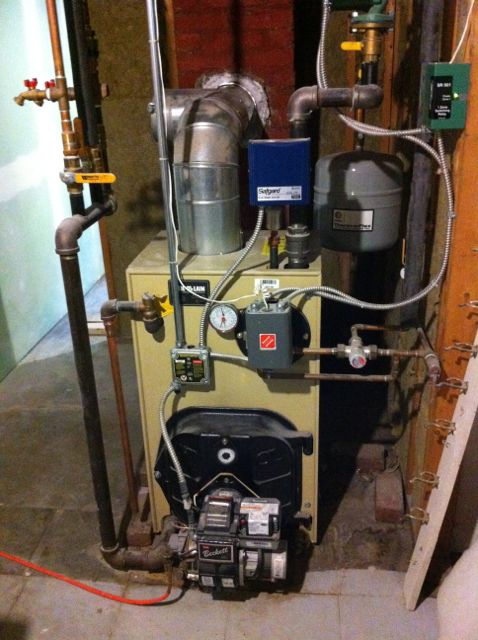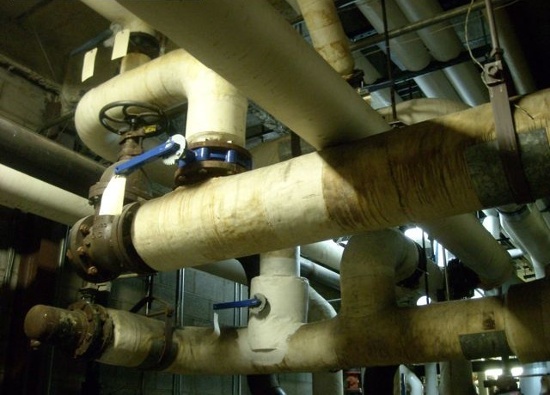Do Boilers for Home Heating Actually Boil Water?

Boilers for heating homes are common in some areas. Not here in Georgia, where I live, but my friends in the colder climates have them. This type of heating equipment takes a fuel like natural gas or fuel oil, burns it to create heat, and then puts that heat into water circulating through the distribution system. Since it’s called a boiler, naturally it’s heating the incoming water up to the boiling point and creating steam. Right?
Most boilers don’t boil
Some boilers do boil water and make steam. Most don’t. If you live in a home built since the middle of the 20th century, any boilers you find therein almost certainly do not boil the water. Instead of steam, they make hot water.
The hot water that comes out of the boiler then goes through a distribution system that dumps the heat into the house to keep you warm. Usually it’s a hydronic distribution system that circulates the hot water throughout the house. The water cools as it passes through radiators or or radiant floor tubes, giving up its heat to the surroundings.
Some boilers are part of forced air distribution. The hot water passes through a hydronic coil in an air handler. The blower blows air over the coil and the warm air is distributed though a duct system. That’s a great way to provide supplemental heat when you have a heat pump.
The demise of steam heating
Since I live in the land of forced air, I don’t deal with boilers and hydronic systems much, so I asked around about steam heating. Dan Holohan, the god of steam heating and the creator of HeatingHelp.com, told me in an email, “Steam was very popular prior to WWII, particularly in the cities. Tract housing, the suburbs, and cheap furnaces killed it after the war.”
I knew that steam engines were dangerous in the past and that’s often cited as one reason that Robert Stirling invented the hot air engine (now known as the Stirling engine). I asked Holohan about that issue, and he told me, “steam boiler explosions were common during the 19th Century.”
A couple of changes, however, made them safe for use in homes. They were the Hartford Loop, mandated by Hartford Steam Boiler Insurance & Inspection Company, and McDonnell’s low-water cutoff. According to Holohan, these changes saved a lot of lives.

I also asked another expert in the field, John Barba of Taco Comfort Solutions, about the reasons behind the demise of steam heating. He told me, “expense, complexity and the virtual cornucopia of alternatives have sent steam the way of the coal stove.” He also explained why it would be difficult to get a new steam heat system today: “The hardest part would be finding someone who could design and install it from scratch.”
Who still uses steam heating?
I also posted my question in the HeatingHelp.com forum and found out a bit more about what steam heating is still out there. Robert O’Brien of Technical Heating on Long Island, NY, said it’s all in older homes. When I asked him if anyone installs steam boilers in new homes, he wrote, “No, no one does. Other than a few eccentrics, most of whom frequent this joint!”
Apparently a lot of older homes that used to have steam heating no longer have it. When the old systems needed to be repaired or replaced, they changed them out for another type. But there’s one big exception. O’Brien looked up some numbers for me and said that 65% of the 1 and 2 family homes in New York City still have steam heat.
There you have it. The two lessons for today are: (1) Most boilers don’t boil, and (2) Go to New York if you want steam heat. Or at least hang out over at HeatingHelp.com and find someone who can help you.
Allison A. Bailes III, PhD is a speaker, writer, building science consultant, and the founder of Energy Vanguard in Decatur, Georgia. He has a doctorate in physics and is the author of a popular book on building science. He also writes the Energy Vanguard Blog. For more updates, you can subscribe to our newsletter and follow him on LinkedIn.
Related Articles
The 3 Types of Heating and Cooling Loads
Heat Pumps and Hydronics – A Great Team for High Performance Homes
Are We Off Track With Combustion Safety Testing?
NOTE: Comments are closed.
This Post Has 8 Comments
Comments are closed.

We have a good number still
We have a good number still in the Capital Region of NY as well. Steam boilers and systems as well as hydronic. If memory serves me and I can find pictures some time I will share but oldest working one I saw was from 1920’s in Schenectady, NY.
I once saw a fully functional
I once saw a fully functional gas steam boiler from 1898, according to the tags, in Scarsdale, NY. It looked like about 2 tons of cast iron. I didn’t see any telltale signs that it originally ran on coal or oil, so my impression was that it was the oldest natural gas boiler I was ever going to see
I am the building engineer in
I am the building engineer in Chicago at a research library with some books dating back to before 1500 and we have two low pressure steam boilers we use for steam humidification and also a reheat system.
We have a good number still
We have a good number still in the Capital Region of NY as well. Steam boilers and systems as well as hydronic. If memory serves me and I can find pictures some time I will share but oldest working one I saw was from 1920’s in Schenectady, NY.
I once saw a fully functional
I once saw a fully functional gas steam boiler from 1898, according to the tags, in Scarsdale, NY. It looked like about 2 tons of cast iron. I didn’t see any telltale signs that it originally ran on coal or oil, so my impression was that it was the oldest natural gas boiler I was ever going to see
I am the building engineer in
I am the building engineer in Chicago at a research library with some books dating back to before 1500 and we have two low pressure steam boilers we use for steam humidification and also a reheat system.
I live in a 104 year old
I live in a 104 year old house that is heated by a 1936 crane sectional boiler. It was an open loop system and I converted it to a closed loop pressurized system. Since I have a wood source, I burn wood instead of coal. There is a small quiet circulation pump on it and it heats the house nicely. The heat is very even compared to a noisy hot air system. I was raised with baseboard hot water so it was a natural.
I live in a 104 year old
I live in a 104 year old house that is heated by a 1936 crane sectional boiler. It was an open loop system and I converted it to a closed loop pressurized system. Since I have a wood source, I burn wood instead of coal. There is a small quiet circulation pump on it and it heats the house nicely. The heat is very even compared to a noisy hot air system. I was raised with baseboard hot water so it was a natural.